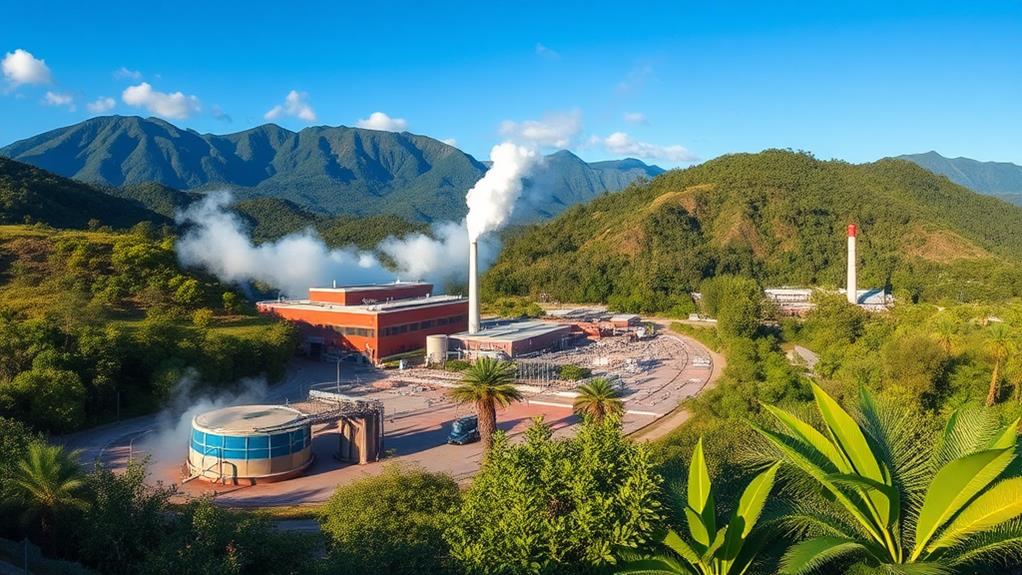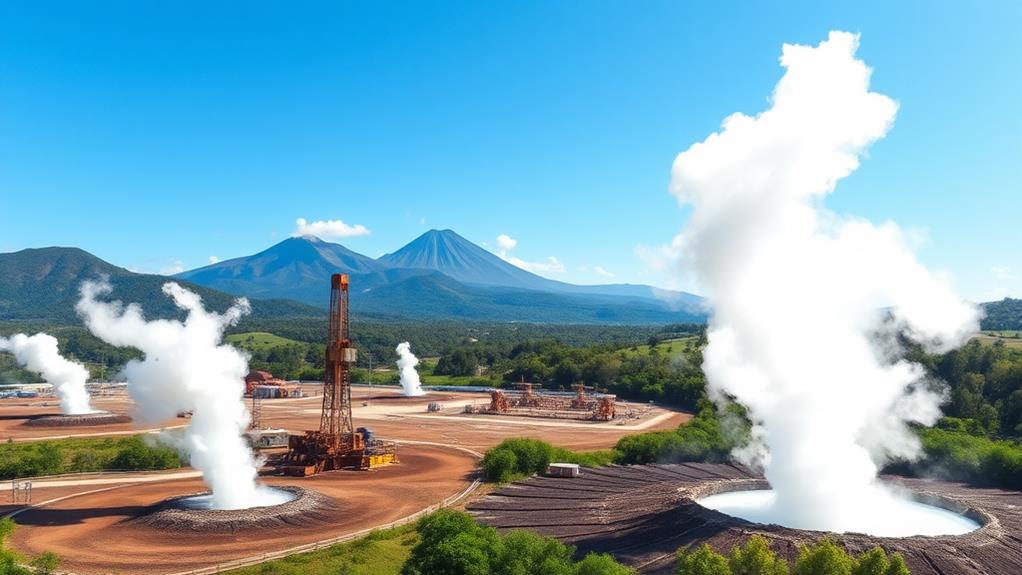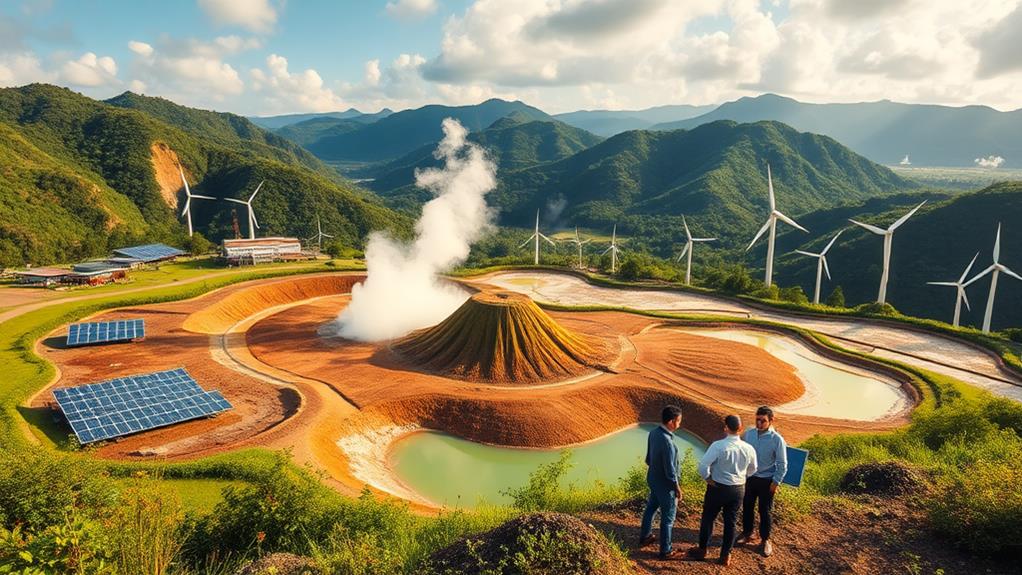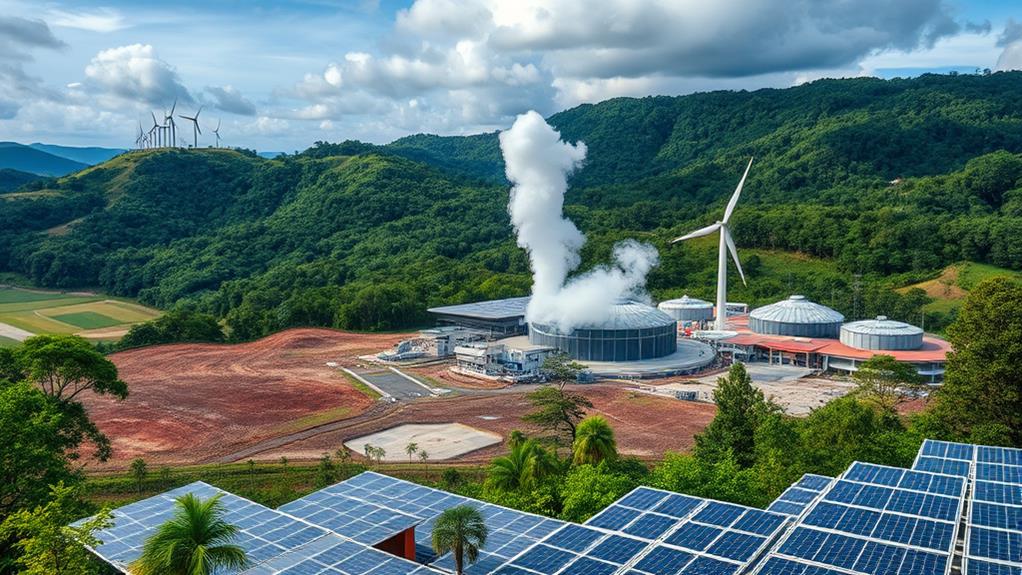The Philippine geothermal energy industry is the third largest in the world. It provides 17% of the country's electricity, with an installed capacity of 1,928 MW as of 2021.
The industry began commercial development in 1979 and has grown due to rich geothermal resources located along the Pacific Ring of Fire. The government supports this sector with incentives like tax holidays.
Key geothermal fields in the Philippines include MakBan and Tiwi. The industry is expected to grow to 2.1 GW by 2025.
However, there are challenges such as financing and the need for regulatory reforms. Despite these challenges, there is strong potential for innovation and further investment, indicating a promising future for geothermal energy in the Philippines.
Overview of Geothermal Energy

Geothermal energy is important for the Philippines, providing about 17% of the country's electricity. It's the second largest source of renewable energy in the nation, which shows the Philippines' commitment to using sustainable energy.
The country has an installed capacity of 1,928 megawatts (MW) as of 2021, making it rank third in the world for geothermal power generation.
The Philippines has many geothermal resources because it's located along the Pacific Ring of Fire. This unique position allows for extensive exploration and development of geothermal energy.
The country started exploring geothermal energy in 1962, and the first commercial geothermal power plants were established in 1979.
The Philippine government supports geothermal energy investment by offering benefits like a seven-year Income Tax Holiday for developers. This help makes the geothermal sector more competitive and promotes growth in electricity generation.
Historical Development in the Philippines
Since 1962, the Philippines has worked hard on its geothermal energy sector.
By 1979, the first commercial power plants were built. This growth was mainly due to the oil crisis in the mid-1970s, which led the government to seek foreign funding and take action to develop this energy source.
By 1984, the country had developed four geothermal fields with a total capacity of 890 MWe, providing about 20% of its electricity.
This effort made the Philippines the third-largest producer of geothermal electricity in the world, after the USA and Mexico.
However, from 1984 to 1999, no new geothermal capacity was added. This lack of growth showed the challenges in expanding the sector to meet increasing energy needs.
It highlighted the importance of ongoing investment and innovation in geothermal development.
Understanding this history is key to seeing how the geothermal energy industry in the Philippines has evolved and what it might become in the future.
Current Geothermal Resources

The Philippines is a global leader in geothermal energy, currently ranked third in the world for installed power generation capacity with 1,928 MW as of 2021. This capacity highlights the country's focus on geothermal as a key energy source.
Key aspects of the Philippines' geothermal resources include:
- Major geothermal fields such as MakBan, Tongonan, Southern Negros, and Tiwi.
- Geothermal energy produces about 17% of the country's electricity.
- The geothermal potential is expected to increase to 2.1 GW by 2025.
- Development of geothermal energy started in 1962, with commercial operations beginning in 1979.
The existing geothermal plants and ongoing exploration provide a strong foundation for future growth.
These resources not only improve energy security but also support the Philippines' renewable energy objectives.
Continued innovation and investment in geothermal energy can enhance capacity, benefitting both the economy and the environment.
Types of Geothermal Power Plants
There are three main types of geothermal power plants that generate electricity using heat from the Earth: dry steam, flash steam, and binary cycle plants.
Dry steam plants are the simplest type; they use steam straight from geothermal reservoirs to turn turbines.
Flash steam plants work differently; they take high-pressure hot water and convert it into steam by reducing the pressure, which helps produce energy.
Binary cycle plants, created in 1967, are an important improvement in geothermal energy technology. They use a secondary fluid that boils at a lower temperature, which allows them to generate power from cooler geothermal resources. This advancement makes geothermal energy production more efficient and increases its potential use.
As of 2021, the Philippines has an installed geothermal capacity of 1,928 MW, making it the third-largest producer of geothermal electricity in the world.
The country's geothermal plants are often located along the Pacific Ring of Fire, where the Earth's heat is more accessible. This helps the Philippines meet its renewable energy goals and provides a sustainable energy source for the future.
Major Geothermal Projects in the Philippines

Geothermal energy projects in the Philippines have established the country as a leader in sustainable power. The first geothermal power plant began operations in Leyte in July 1977, with a capacity of 3 MW. This marked the start of geothermal energy in the country.
The Tiwi geothermal power plant followed in 1979, increasing capacity to 110 MW, showing that large-scale geothermal energy production was possible.
By December 2009, the total installed geothermal capacity reached 1,904 MW, making the Philippines the third largest producer of geothermal energy in the world.
More recently, the Maibarara Geothermal Power Plant-2 was launched on March 9, 2018, adding 12 MW to the country's energy supply.
These projects demonstrate the Philippines' potential for geothermal energy, with predictions estimating a generation capacity of 2.1 GW by 2025.
This focus on geothermal projects highlights the Philippines' commitment to renewable energy sources and sustainable development.
Environmental Impact and Sustainability
The Philippines is increasing its geothermal energy capacity, making environmental impact and sustainability important. Geothermal energy is eco-friendly, producing only about 45 grams of CO2 per kWh, which is much lower than fossil fuels. This reduction in greenhouse gas emissions shows that geothermal energy can help meet sustainability goals. The Philippines plans to generate over 500 GWh of geothermal energy by 2030, showing its commitment to renewable resources.
However, there are challenges in geothermal development. Sustainable management practices, such as fluid injection, can reduce risks like land subsidence and induced seismicity. This approach helps protect the environment.
The total heat content for geothermal energy is estimated at 1×10^10 TJ, but the energy extracted is still very low, which supports long-term use.
It is essential to use comprehensive environmental management strategies when planning geothermal projects. These strategies assess hazards and minimize risks from volcanic-geothermal systems. This ensures that the growth of the geothermal sector aligns with environmental protection and sustainability goals.
Economic Factors and Investment Opportunities

The Philippine geothermal energy sector is growing steadily, making it a good place for investment. The installed capacity has increased from 1,916 MW in 2017 to 1,928 MW in 2021, indicating a healthy market.
There is significant growth potential. The geothermal energy generation could reach 2.1 GW by 2025, which means more opportunities for exploration and development.
The government offers attractive incentives. These include tax holidays and duty-free imports, which encourage both local and foreign investments.
Operating costs are low. Although the initial costs to set up geothermal energy systems can be high, ranging from $2,500 to $5,000 per installed kW, the operating costs are very affordable at $0.01 to $0.05 per kWh. This helps ensure that projects can be profitable over time.
Foreign ownership options have improved. A 2020 amendment allows 100% foreign ownership for projects over $50 million, which can attract larger investments into the sector.
Government Policies and Support
The Philippine government actively supports the geothermal energy sector through several policies. These policies attract investment and promote sustainable energy. For example, developers benefit from a seven-year Income Tax Holiday, duty-free importation, and tax credits. These incentives reduce financial obstacles for those involved in geothermal energy projects.
As of 2021, the total renewable installation capacity in the Philippines was 7,617 MW. This shows the country is committed to increasing renewable energy, including geothermal.
A significant policy change in October 2020 allows foreign ownership of geothermal projects over $50 million to reach 100%. This aims to attract more foreign investment and improve technology and expertise in the field.
Additionally, the Green Energy Options program allows consumers to select renewable energy sources. This initiative directly supports the growth of geothermal energy.
How Does the Geothermal Energy Industry in the Philippines Compare to the Oil and Gas Industry in Terms of Environmental Impact and Sustainability?
The geothermal energy industry in the Philippines is more sustainable and less environmentally impactful compared to oil and gas production offshore. Geothermal energy produces minimal greenhouse gas emissions and has a small land footprint, while offshore oil and gas production can lead to spills and habitat destruction.
Future Trends and Challenges

The Philippine geothermal energy industry is expected to change significantly in the next few years. There's a potential to increase the generation capacity by 2.1 GW by 2025. This growth highlights the importance of exploring and developing geothermal resources to meet the rising demand for energy.
Regulatory reforms are essential to attract foreign investment. The government is offering incentives to lower initial costs for developers. By addressing institutional barriers, project implementation can become smoother. Additionally, integrating geothermal energy with the electric grid will enhance energy security.
Currently, the Philippines has the third-largest installed geothermal capacity in the world at 1,928 MW. However, slow development over the past decade has limited progress.
To move forward, it's crucial to overcome financing limitations and ensure consistent policies. This will help maintain political stability and attract more investments. Connecting geothermal energy to inter-island electric grids will improve reliability and help distribute energy more efficiently across the country.
As these trends develop, the Philippine geothermal sector has a chance to grow, but it faces challenges that require innovation and strategic reforms. Successfully addressing these issues will shape the future of geothermal energy in the Philippines.
Comparison With Other Renewable Sources
Geothermal energy is important in the Philippines, providing about 17% of the country's electricity. It is the second-largest renewable energy source after hydroelectric power. The Philippines is also third in the world for installed geothermal capacity, making it a vital part of the energy supply.
Here is how geothermal energy compares to other renewable sources:
| Renewable Source | Key Advantage |
|---|---|
| Geothermal | Stable energy supply, 24/7 operation |
| Solar | Low installation cost, abundant |
| Wind | High potential output in suitable areas |
Geothermal energy is reliable because it produces power continuously, unlike solar and wind energy, which can only produce power when the sun shines or the wind blows. Geothermal energy has a low environmental impact, emitting only 45 grams of CO2 per kWh, which is much less than fossil fuels. Although solar and wind also have low emissions, they often face challenges with energy storage and reliability.
Currently, geothermal energy is underutilized in the Philippines. With more government support and foreign investment, it could grow even more. This would help geothermal energy compete better against wind and solar, which have more complicated regulations and market challenges.
Questions and Answers
What Are the Challenges of Geothermal Energy in the Philippines?
Geothermal energy in the Philippines faces several challenges. Regulatory framework inconsistencies make it hard for companies to navigate the rules for starting projects. For example, changes in laws can delay permits and increase costs. There are also limited investment opportunities, which means fewer financial resources for developing geothermal plants.
Community engagement issues arise when local residents are not properly informed or involved in the decision-making process. This can lead to opposition against geothermal projects. Lastly, environmental impact concerns are significant. For instance, drilling for geothermal energy may affect local ecosystems and water sources.
To overcome these problems, advancements in drilling technology are necessary. Improved techniques can make drilling faster and less expensive. Additionally, better resource management practices can help ensure that geothermal energy is used sustainably.
What Makes the Philippines a Good Producer of Geothermal Energy?
The Philippines is a top producer of geothermal energy. This is mainly because it has a lot of volcanic activity, which creates the right conditions for geothermal energy. For example, areas like Leyte and Negros are known for their geothermal power plants.
Geothermal energy is renewable. This means it can be used over and over without running out. The Philippines uses steam from the Earth to generate electricity, which helps reduce dependence on fossil fuels.
There are environmental benefits to using geothermal energy. It produces very low greenhouse gas emissions compared to coal or natural gas. For instance, the Makban Geothermal Power Plant has significantly lower emissions than traditional power plants.
Sustainability is another important factor. Geothermal resources can be managed wisely to ensure they last for many years. The government monitors these resources to maintain their productivity.
The economic impact is positive. Geothermal energy creates jobs and supports local economies. For example, the development of geothermal facilities in the Philippines has provided employment for thousands of people.
Technological advancements have improved efficiency. New methods and technologies have made it easier to harness geothermal energy. Enhanced geothermal systems, for example, allow for energy production in areas that were previously not viable.
A supportive policy framework encourages growth in the geothermal sector. The Philippine government has implemented laws and incentives to attract investments in renewable energy. Programs like the Renewable Energy Act promote the development of geothermal resources.
What Are the 7 Geothermal Power Plants in the Philippines?
The seven geothermal power plants in the Philippines use heat from the Earth to produce energy. These plants include Makban, Tiwi, Bacman, Kidapawan, Malitbog, Tongonan, and Southern Negros. Each of these plants converts geothermal energy into electricity, making it a renewable resource.
The plants benefit from advanced technology that improves their efficiency. For example, binary cycle plants allow lower temperature geothermal resources to be used for power generation.
Government support through favorable policies encourages investment in geothermal energy. This makes it easier for companies to develop and operate power plants.
What Is the Trivia About Geothermal Energy in the Philippines?
Geothermal energy in the Philippines is an important source of renewable energy. The Philippines ranks third in the world for geothermal energy production. This energy comes from the heat stored beneath the Earth's surface. The country has several geothermal power plants, such as the Makban Geothermal Power Station and the Tongonan Geothermal Power Plant.
Geothermal energy is beneficial for the environment because it produces much lower greenhouse gas emissions compared to fossil fuels. It also provides economic gains by creating jobs and reducing energy costs. Overall, geothermal energy plays a critical role in the Philippines' commitment to sustainable energy solutions.